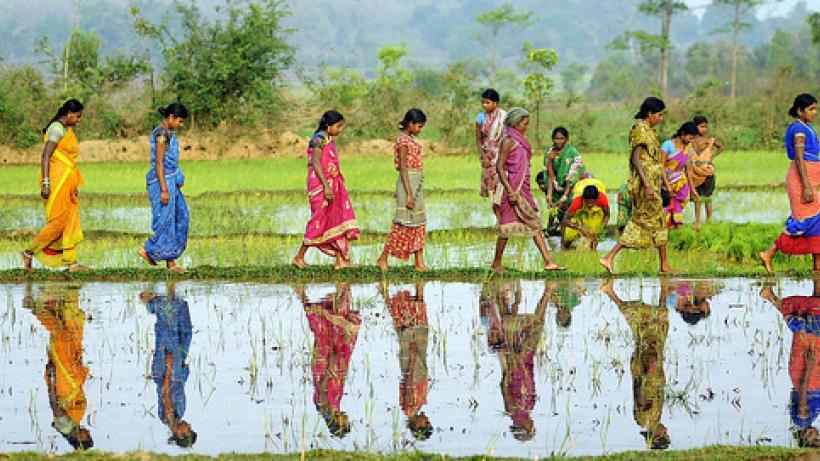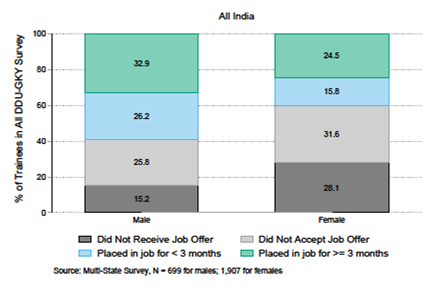
Vocational training programs in India are leaving women behind, but this needn’t be the case
Less than 25% of women are employed in their skilled job for more than three months and are also less likely to receive and accept job offers than men. Migration is a key constraint, with job location being a strong predictor of female outcomes.
Skill India
Many low- and middle-income countries have launched government-funded vocational training programmes to help youth integrate into labour markets and spur economic growth. India, with its burgeoning youth population, has a major impetus for improving the skills of young people. This accounts for the initiation of the Skill India initiative in 2014, which initially set out to train 500 million youth by 2022. A key challenge in India is to recruit and train a large rural labour force for mostly urban jobs. Skill India promises to do just that.
Vocational training, gender and mobility
We have little evidence of the efficacy of vocational training programmes, and what we do know suggests that success is quite varied (McKenzie, 2017). While existing evidence suggests some programmes can directly benefit women (Attanasio et al., 2011; Bandiera et al., 2017), it is not clear who these programmes in fact benefit.
Skill India’s focus on urban migration may limit the involvement of women, whose migration may be constrained by a variety of factors. Women in India, similar to those in some other developing contexts, are subject to gender-biased norms that constrain their work, mobility, information, and access to networks (Farré and Vella, 2013; Jayachandran, 2015; Croft et al., 2014; Beaman et al., 2018).
Accordingly, despite investing millions of dollars in various programmes under the aegis of Skill India, not much is known about how well these programmes address specific constraints to women’s participation and success.
Two key questions remain unanswered:
- Are women being left behind by vocational training programmes?
- How can these programmes address underlying barriers to women’s participation in vocational training and labour markets?
The study:
To address this knowledge gap, we conducted a survey in collaboration with a major Indian government vocational training programme for below poverty line, rural youth. This programme trains youth age 15 – 35 via publicly-funded, private training agencies, in a variety of trades, free of charge. Youth are then placed in formal-sector, above minimum wage jobs, often in urban centres, across the country.
The methodology
Our survey, conducted over the phone with 2,600 former trainees (1,900 women) from seven major states (Bihar, Chhattisgarh, Gujarat, Madhya Pradesh, Odisha, Rajasthan, Uttar Pradesh), asked youth about their training, job placement, and migration experiences.
The findings
Our data shows that women are being left behind:
- Figure 1 shows the leaky pipeline that results in less than 25% of women being employed in their skilled job for more than three months.
- Unfortunately, results for men are only slightly better, at 33%.
- Women are also less likely to receive and accept job offers than men.
- That said, when women are placed in jobs, they remain in them as long, or longer than, men

Migration: A key constraint for women
Job locations are strong predictors of female outcomes. While female trainees are less likely to both receive job offers and accept those offers after skilling than men, they are even less likely to accept jobs that require migration.
Figure 2 plots predicted job placement rates for men and women conditional on job location, holding education, caste, age, trade of training, natal district, and training agency constant. It shows that women are less likely than men to accept jobs overall, but also that this gap widens for jobs farther from their homes.

The biggest reasons women reported dropping out of the labour force revolve around family-related challenges and difficulty migrating. Men, on the other hand, report challenges related to low pay and unfavourable working conditions.
Migration support for women workers
Migration support may counteract this leaky pipeline and improve female employment outcomes. Our survey evidence suggests that access to migration support was associated with higher labour force participation and longer job tenure (see Figure 3).
Respondents who migrated for work and had left their jobs were asked whether they received any of seven different types of migration support:
- Assistance finding accommodation
- Opening a bank account
- Setting up an account to receive government benefits
- Obtaining a phone number or SIM
- Finding food
- Finding medical help
- Using public transport
Figure 3 shows mean job duration for former trainees’ conditional on how many forms of migration support the youth received, irrespective of type. Receiving more migration support is associated with longer job durations. That said, this relationship is purely correlational since longer job tenure may increase exposure to potential support.

The case of Odisha
Vocational training need not be gender-regressive: some states achieved parity in terms of training and placement outcomes for men and women. While our survey suggests women fare worse than men on a variety of labour market outcomes overall, results varied significantly by state.
In the context of a broader research-policy engagement with the state of Odisha, our research team evaluated administrative data from over 100,000 trainees. They found that the state achieves remarkably better than average results for women, in terms of employment outcomes.
For example, women are more likely than men to be placed in jobs for at least three months, and 55% of female trainees were placed in jobs for three months or longer. Crucially, these strong results did not reflect a tendency to place women in jobs near their homes: instead, most of Odisha’s female trainees migrated for their jobs.
Implications
Taken together, these results suggest that relatively poor female training and employment outcomes need not be a given under Skill India. Vocational training programmes can be designed in such a way as to alleviate gender-specific constraints and usher women into the labour force.
Even so, there is still much to learn. Important areas for future inquiry include the rigorous testing of specific practices aimed to support women’s training enrolment and improve their employment outcomes, particularly in the context of urban migration.
References
Attanasio, O., Kugler, A. and Meghir, C. (2011). "Subsidizing Vocational Training for Disadvantaged Youth in Colombia: Evidence from a Randomized Trial", American Economic Journal: Applied Economics, 3(3): 188-220.
Beaman, L., Keleher, N. and Magruder, J. (2018). “Do Job Networks Disadvantage Women? Evidence from a recruitment experiment in Malawi”, Journal of Labor Economics, 36(1): 121-157.
Bandiera, O., Buehren, N., Burgess, R., Goldstein, M., Gulesci, S., Rasul, I. and Sulaiman, M. (2017). “Women’s Empowerment in Action: Evidence from a Randomized Control Trial in Africa”, Working Paper.
Croft, A., Schmader, T., Block, K. and Baron, A. S. (2014). The second shift reflected in the second generation: Do parents’ gender roles at home predict children’s aspirations?, Psychological Science, 25(7), 1418-1428.
Farré, L. and Vella, F. (2013). “The intergenerational transmission of gender role attitudes and its implications for female labour force participation”, Economica 80(318): 219-247.
Jayachandran, S. (2015). “The roots of gender inequality in developing countries”, Annual Review of Economics. 7(1): 63-88.
McKenzie, D. (2017). How Effective Are Active Labor Market Policies in Developing Countries? A Critical Review of Recent Evidence, World Bank Group, Development Research Group, Finance and Private Sector Development Team. Policy Research Working Paper 8011.

